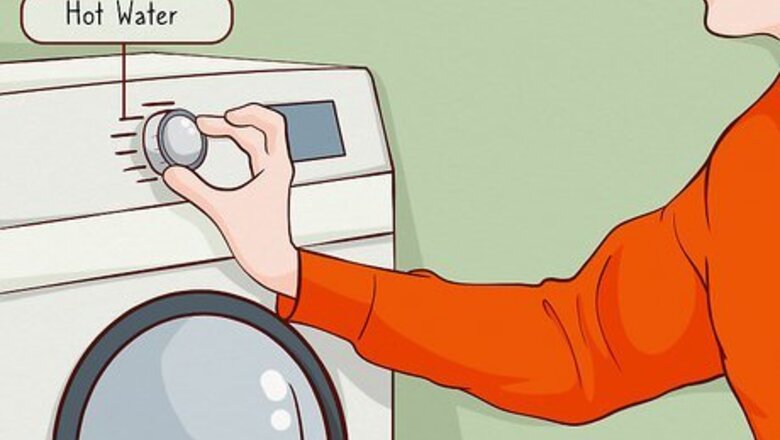
views
Freshening the Bedding
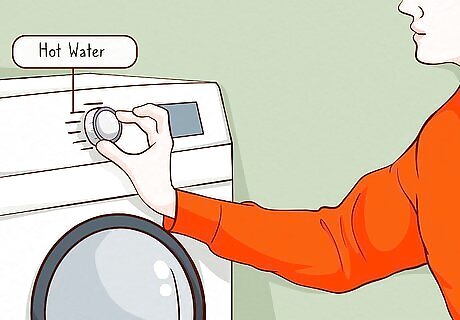
Wash all your linens and the mattress cover in hot water. Throw the pillow cases, sheets, comforter, and even the mattress cover into the washing machine, as long as they’re all machine washable. Use hot water (or the highest temperature setting indicated on the manufacturer’s instructions) in order to kill any dust mites living on the sheets. If your linens aren’t machine washable, take them to the dry cleaners to be cleaned. This should be the first thing you do during the entire spring cleaning process. That way, you can clean most of the rest of your room in the time it takes your linens to be washed and dried.

Run your pillows through the washing machine, if possible. Many standard pillows are machine washable, but make sure to check the manufacturer’s instructions before throwing your pillows in the wash. For best results, only wash 2 pillows at a time to avoid overloading the machine. Do not put your pillows in the wash if they contain feathers, as the machine washing process can cause permanent damage to the feathers. Check your pillows to see if you want to replace them. Old pillows could contain dust mites, dead skin, and bacteria. Try to replace your pillows every 1-2 years.
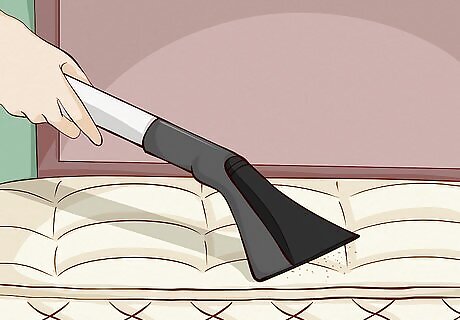
Vacuum the surface of the mattress to get rid of any dust or dirt. For best results, use the wide brush attachment and vacuum the mattress with the vacuum hose. Be sure to vacuum the crevices, edges, and corners of the mattress as well, since debris tends to accumulate in these areas. Note that if you rotate your mattress as part of your spring cleaning regimen, you’ll have to vacuum the other side of the mattress as well. Make sure the vacuum hose and brush attachment are both clean before you begin vacuuming the mattress.
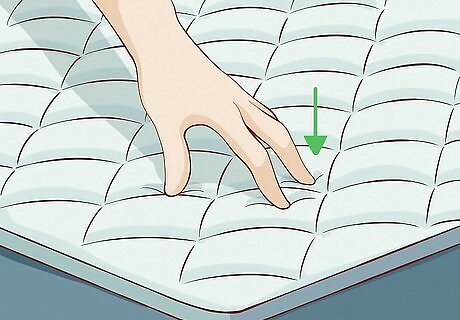
Inspect the mattress for signs of damage. Look for lumps, rips, or any other signs of physical wear and tear that need to be addressed. If the damage isn’t that bad, you can usually just sew any rips or holes shut. However, if your damaged mattress is more than 7 years old, opt to replace it instead. Most experts recommend replacing your mattress every 8 years, whether it’s seriously damaged or not. Having a damaged mattress can make it harder for you to fall asleep and stay asleep, so it’s important to address any damages in your mattress as soon as possible.

Clean any stains on the mattress with mild soap and cold water. Don’t use cleaning solutions with harsh chemicals, as these may end up damaging the upholstery on your mattress. Instead, mix a few drops of mild dishwashing soap into a bucket of cold water. Use a sponge dipped in this soapy water mixture to spot clean any stains on the mattress. If this soapy water mix doesn’t get a stubborn stain out, try sprinkling a small amount of baking soda onto the stain and letting it sit for a few minutes before cleaning it with a damp sponge.

Use a damp cloth to clean any dust off of the bed frame. Use a microfiber cloth for the absolute best results, although any ordinary cloth will also work. Go back over the frame with a second dry cloth to remove any excess moisture left behind by the damp cloth. If you have a headboard at the top of your bed, use the damp cloth to clean it as well.
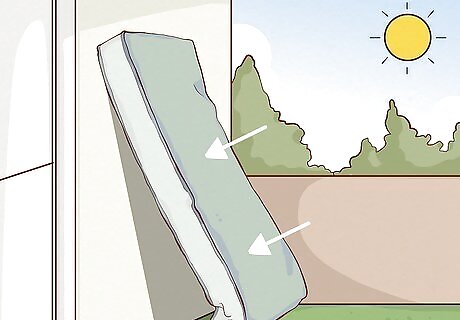
Allow the mattress to air dry before putting the linens back on it. Place the mattress in direct sunlight and leave it for a few hours. After the mattress has dried, flip it over to rotate it, if this is recommended by the manufacturer. Read the tag on your mattress to find out whether the manufacturer advises if you should rotate your mattress on an annual basis. If only a few parts of the mattress are wet, you can also opt to use a hairdryer on warm on these spots to dry them quickly. Never use a hairdryer on hot, though, as this may start a fire on your mattress.
Getting Rid of Dust
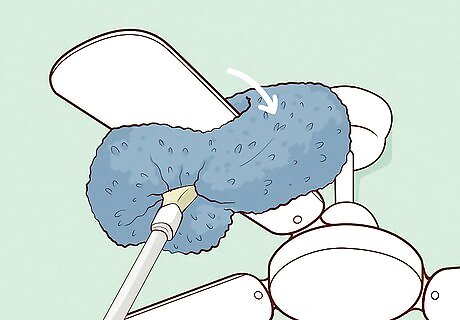
Use a long-handled duster to dust the ceiling fan. Make sure the ceiling fan is turned off before you begin dusting it. If you don’t have a long-handled duster, you can also place an old pillowcase over each fan and slide it along the fan blade to collect the dust. For maximum safety, wear a breathing mask and goggles while you do this. Your ceiling fan is probably a lot dustier than you think it is! If you need to dust a fan over your mattress, cover the mattress with a sheet first so it doesn’t get dirty.
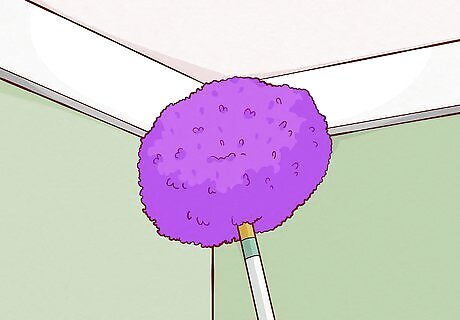
Dust the ceiling and the top half of your walls first. Always start dusting from the top of the room so that you won’t have to dust anything twice. Make sure you get the dust out of any air vents and the top corners of your room as well, since it can be easy to forget to clean these areas on a normal basis. Use a step-ladder to reach the ceiling if you don’t have a long-handled duster. If you don’t have a long-handled duster or a step-ladder, you can also put a rag over the head of a broom and use that to dust the ceiling.
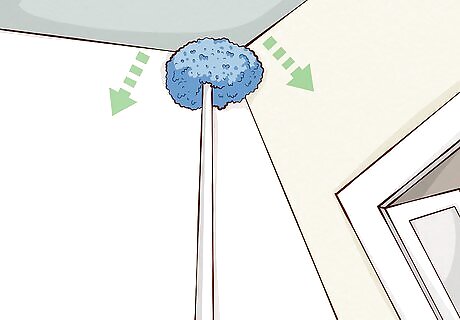
Work your way down to the lower half of the walls and the baseboards. Dust the walls themselves, the corners, and any air vents that you haven’t dusted yet. Make sure to dust the inside of any window frames in your room as well. Don’t forget to dust around the moulding of your windows, as well.
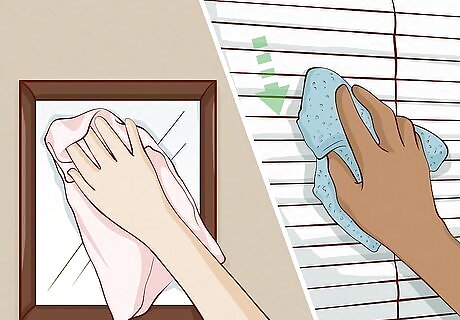
Use a microfiber cloth to dust picture frames and the window blinds. Spray glass cleaner on the cloth before using it to clean the picture frames. If you have vinyl window blinds, use a mild surface cleaner sprayed on the cloth to clean them.
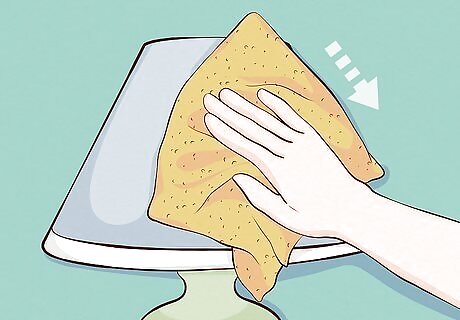
Clean the bulbs, shades, and cords for any lamps in your room. Take the shade off of the lamp, then use a lint remover to clean the inside and outside of the lampshade. Make sure the bulb is cool before wiping it down with glass cleaner. You can simply use a damp cloth to wipe any dust off of the lamp cord. However, make sure the cord is unplugged first.
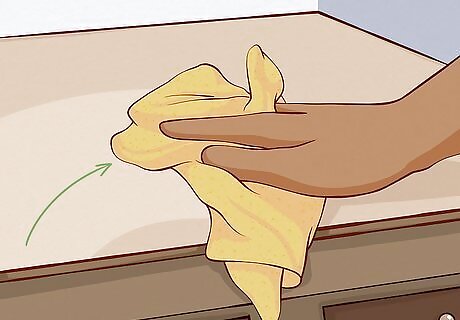
Don’t forget to dust all the furniture in your room. Wipe down your dresser, desk, bookshelf, or any other piece of furniture in your room with a duster or with furniture polish. This is especially important if you don’t already dust your furniture on a regular basis. Take this opportunity to wipe down the insides of your dresser drawers, as well.
Cleaning the Floor
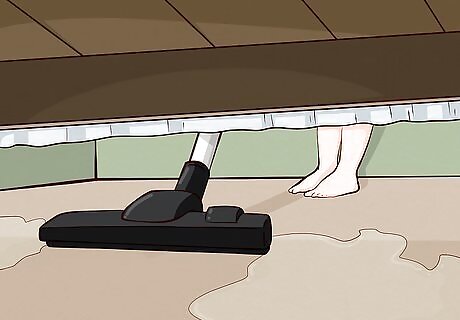
Use vacuum extensions to vacuum underneath the bed. Use the vacuum hose with an extender and floor attachment to get a deep reach under the bed. If you have other furniture in your room with space underneath it, clean these spaces as well. For example, if you have a bookshelf or chest of drawers that doesn’t go all the way to the ground, that empty space will need to be vacuumed.
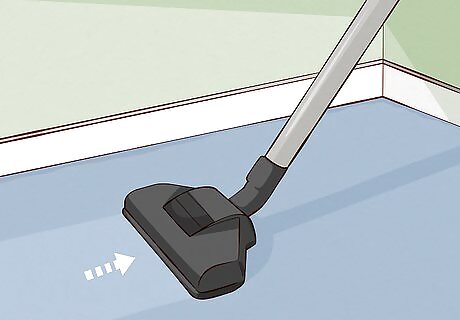
Vacuum and mop the floor if you have hardwood floors. Use a vacuum cleaner set on the hardwood setting to clean any dust and dirt off the floor first. Mop the floor with a mop and commercial hardwood cleaner to clean and polish the floor. Commercial hardwood floor cleaners are usually available to purchase at most grocery stores. If your vacuum cleaner doesn’t have a hardwood floor setting, you can also use a broom and dustpan to clean the floor.
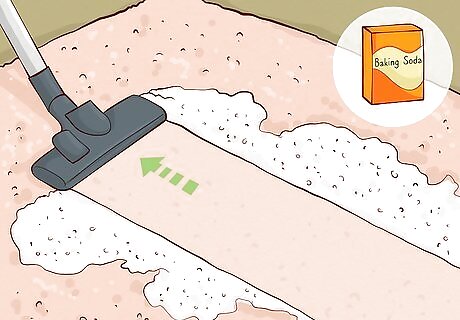
Sprinkle baking soda into the carpet, then vacuum it twice. Pour a thin amount of baking soda across the surface of your floor if it’s carpeted and let it sit for 5 minutes before vacuuming. Vacuum the floor once in each direction (i.e., once going horizontally and once going vertically) to make sure you clean all of the baking soda off of the floor. The baking soda will help remove any odors that have accumulated in your carpet fibers.
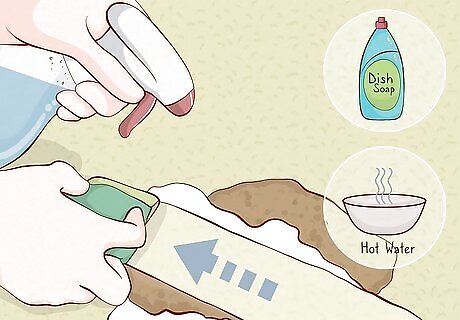
Use dish detergent and hot water to treat carpet stains. Mix equal parts of hot water and dish soap in a spray bottle, then spray this mixture onto the stain. Use a clean cloth to blot the stain and transfer the colored liquid from the carpet fibers to the cloth. Continue blotting this way until the stain is completely gone. You may need to switch to a second clean cloth if the stain is too large for your first cloth to handle. If this mixture of dish detergent and water doesn’t do the trick, use a mixture of unscented ammonia and water instead.
Decluttering and Organizing Your Room
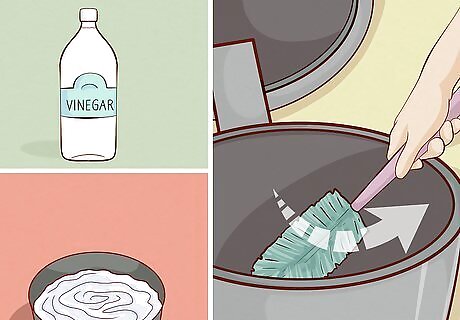
Empty and clean out any trash cans in your room. Mix 2 parts hot water and 1 part vinegar in a medium-sized bucket. Then, dip a stiff scrub brush into this mixture and use it to clean the inside of your garbage cans. Rinse the cans thoroughly and allow them to air dry before putting any bags inside them. Take the old garbage bags to the dumpster or to your local municipal garbage dump. If the garbage in your room often has an odor, consider replacing your old garbage bags with odor-free or scented trash bags.
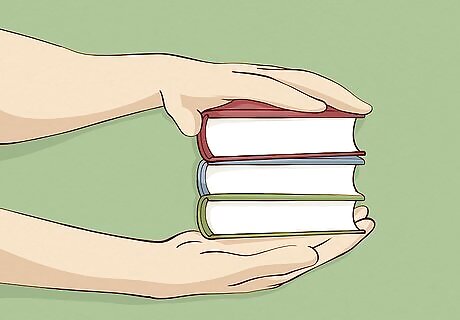
Collect any items that you don’t want to keep in your bedroom. Go around and pick up any books, dishes, clothes, or any other items that belong in some other area of your home. Eliminate visual chaos in your room by removing anything that makes your room feel cluttered. It’s ok to keep a few things by your bed, such as a book or a scented candle, but the more things you can take away from this area, the easier it will be for you to feel relaxed in your room.
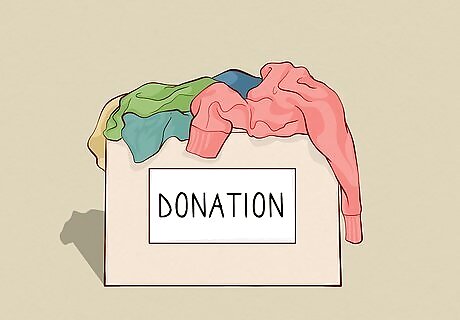
Throw away or donate any clothes that you haven’t worn in 2 years. Go through your closet and pull out any clothes that you either haven’t worn in this much time or that you don’t plan on wearing again in the future. If there are any clothes that you want to keep for sentimental reasons, put them in a storage box instead of in your closet. If there are any clothes that you feel uncertain about throwing out, put these in a storage box as well. If you later find that you want to wear them again, take them out of the box. If you never end up wanting to wear them, you can toss them out at a later date.
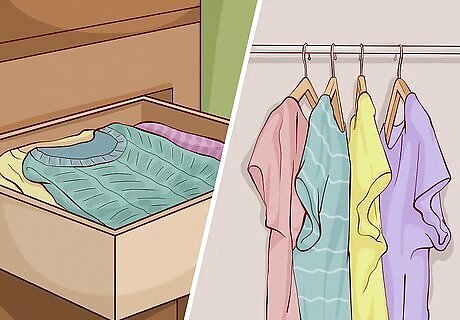
Make sure your closet and dressers are neatly organized. Keep your spring and summer clothes are put on hangers and drawers in a convenient location. Put the winter clothes that you won't wear until next year in storage with some mothballs and lavender bags if you have them. Dust all the shelves and corners before putting all your things back neatly. Fold individual clothing items into neat squares before placing them back in your dresser drawers. Don’t put any clothing items on the floor of your closet except for shoes.
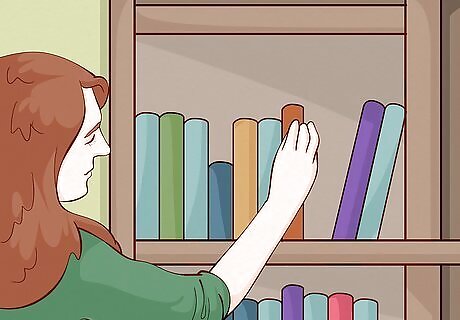
Remove any furniture in your room that isn’t actually necessary. Take a look around and make a note of any piece of furniture, such as a half-empty bookshelf or bare coffee table, that you don’t actually need in your room. Getting rid of these items of furniture or moving them to a different room will free up a ton of floor space, leaving your room feeling much larger as a result. For example, if you have 2 small bookshelves with only a few books on each of them, consider investing in a new, larger bookshelf. Place all of your books on this large bookshelf and move the smaller shelves to a separate room in your home.



















Comments
0 comment